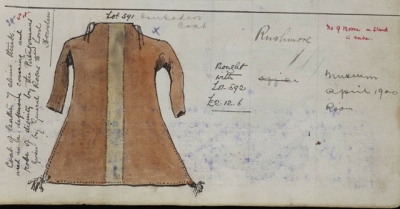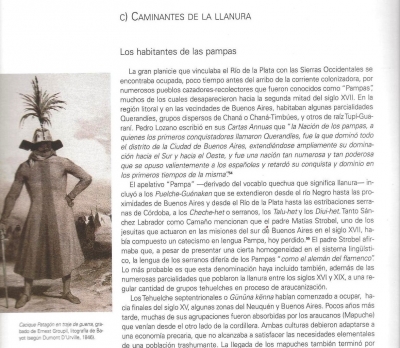Tehuelche body armour [Add.9455vol2_p398/2]
Peter Rivière
In Pitt-Rivers’ Second Collection there is a leather suit of body armour from the Tehuelche Indians of the Pampas region of Argentina. Its entry in the catalogue is (Add.9455vol2_p398/2). It was Lot 591 at Christie’s sale of the Londesborough Collection in July 1888. It was bought together with Lot 592, which was composed of an Indonesian wooden shield (Add.9455vol2_p395/2) and an Ethiopian shield (Add.9455vol2_p395 /3), all three items costing £2 12s 6d (£228.00/£1,110.00 in 2010 prices). [1]. The catalogue description reads:
‘Coat of leather 7 skins thick used as a defensive covering and robe of dignity by the Patagonians. Given by General Rosas to Lord Horden.’
The coat was first housed at Rushmore and in 1900 moved to Farnham Museum. It was acquired by a dealer James Economos at some point during the general dispersal of the collections from Farnham after the Second World War. Economos is a well known American dealer in tribal and other art based in Santa Fe, New Mexico. In 1972 the National Museum of the American Indian [MAI] in Washington obtained the coat through an exchange with Economos. The MAI records show that it also received in the exchange a Crazy Horse bonnet and other objects for which it handed over 15 assorted North American Indian items. The coat is still held by MAI with the catalogue number 24/7495. The catalogue entry reads:
‘Heavy plaited coat of armor (or “robe of dignity”). Leather garment seven skins thick; painted with yellow vertical strip on beige background. Collected by General Juan Manuel Rosas in 1832-1833. Given by him to Lord Howden thence to Lord Londesborough, 1880. Ex. Coll. Pitt-Rivers Museum.’
In the description of the coat the skins are identified as being horse hide. [2]
The Tehuelche were one the nomadic people who inhabited the Pampas and Patagonia regions of Argentina. During the 18th century their traditional way of life had been much altered by their adoption of the horse which had been introduced by the Spanish and had had a similar effect to that much better recorded for the Plains Indians of North America. In the 19th century the Tehuelche along with most of the native peoples of Southern Argentina were conquered and virtually exterminated by what are known as the two ‘Conquests of the Desert’. Remarkably little was ever recorded about the Tehuelche’s society and culture, It is known that the eastward migration of the Auracanians from the Andean district had had a strong influence by the beginning of the 19th century. It is also known that the Auracanians were using armour made from seal skins in pre-Hispanic times, and later from cowhides. [3]
The 18th century English traveller, Thomas Falkner, gives us this description of Tehuelche armour:
Their defensive arms consist of a helmet, made like a broad-brimmed hat, of a bull’s hide sewed double, and of a coat of mail; which is a wide tunic, shaped and put on like a shirt, with narrow short sleeves, made of three or four folds of the anta’s skin. It is very heavy, strong enough to resist either arrows or lances; and some say it is bullet-proof. It is made very high in the neck-part, and almost covers the eyes and nose. On foot they use likewise a large unwieldy, square target, of bulls hides. [4]
Robert Fitzroy, Captain of HMS Beagle, visited the Tehuelche in the 1820s, some 50 years after Falkner, and provides a very similar account:
Another kind of armour, worn by those who can get it is a broad-brimmed hat, or helmet, made of double bull’s hide; and a tunic, or frock, with a high collar, and short sleeves made of several hides sewed together; sometimes of anta [tapir] skin, but always of the thickest and most solid they can procure. It is very heavy, strong enough to resist arrows or lances, and to deaden the blow of a stone ball (bola perdida). [5]
Fitzroy’s account, where he states ‘worn by those who can get it’, suggests, assuming this applies to the coat as well as the hat, an explanation of the description of the object as a ‘robe of dignity’. At the least the remark implies that only those of higher status owned such objects, leaving open the possibility that it also had some ceremonial function.
Finally, although the item is described as being from Patagonia, the Southern Tehuelche who lived in that region did not have horses at the time and de Rosas’s contacts and movements seem to have been limited to the Northern or ‘Horse’ Tehuelche. Accordingly the coat might more accurately be described as from the Pampas region.
Juan Manuel de Rosas (1793-1877) was a military officer and politician. He was Governor of Buenos Aires Province 1829-32, and Governor of the Argentine Confederation 1835-52. During the latter period he ruled more or less as a dictator or caudillo in Latin-American terms. During his rule there was a state of almost constant civil war, often with the intervention of neighbouring countries and even France and Great Britain. He was finally overthrown in 1852 when he left Argentina to live the rest of his life in Hampshire, England. When still a boy de Rosas went into the interior to work on the farm of relatives and in due course started a ranch of his own which was very successful. His land abutted the territories of the Tehuelche and Ranqueles (an Auracanian group) so he organised his gauchos into a military force to combat the raids by these peoples. He did not, however, object to all the Tehuelche whom he divided into three groups, ‘friends’, ‘allies’ and ‘enemies’. Friends were allowed to settle within the Province of Buenos Aires and de Rosas accepted groups on to his own land. Allies were permitted to retain their own territories and independence, but war was made against the enemies of whom some 3,200 were killed in the first ‘Conquest of the Desert’ in 1832, in which campaign de Rosas was one of the military commanders. When, from whom and under what circumstances de Rosas obtained the coat is not known, but clearly he had many opportunities on which to do so given his frequent and variable contacts with the Tehuelche. [6]
We are able to pinpoint with greater certainty when de Rosas gave the coat to Lord Howden.
John Hobart Caradoc, the second Baron Howden (1799-1873), a soldier turned diplomatist, was appointed minister at Rio de Janeiro in 1847 with a special mission to the Argentine Confederation and the Republic of Uruguay. The diplomatic question involved related to the series of civil wars that wracked the region during de Rosas’s governorship. France had been involved for some years and Great Britain had joined her in blockading the Rio de la Plata. Baron Howden’s task was to agree a treaty bringing the conflict to an end. He was in Argentina for a few months in 1847, and it is almost certainly then, while he was negotiating with de Rosas that the latter gave him the Tehuelche coat. [7]
We have no information on how and when the coat passed into the hands of its next owner, Albert Denison, the first Baron Londesborough (1805-60). Denison was the son of Henry Conyngham and changed his name in 1849 to Denison, his mother’s maiden name, to comply with his uncle’s will by which he inherited enormous wealth. With this wealth he bought three large estates in Yorkshire including Grimston Park, near Tadcaster. This last was acquired from Lord Howden and it is worth speculating that the Tehuelche coat was included in the sale.
Londesborough was a keen antiquarian and collector. He was a fellow of the Society of Antiquaries and the Royal Society, he was first president of the British Archaeological Association, vice-president of the Archaeological Institute, president of the Numismatic Society, and vice-president of the British Association meetings in Hull in 1853. He was also an active field archaeologist. Among other things his collection included a wide range of high quality armour. In other words, the Tehuelche coat would have fitted perfectly with his interests. His health was not good; he died relatively young in January 1860 and was buried at Grimston, Lord Howden’s former estate. His collections were dispersed in a series of sales in 1879, 1884 and 1888. [8]
Pitt-Rivers acquired no objects from the Londesborough 1879 sale, but obtained 23 items in 1884 and a further 50 in 1888. In 1884 the items were mainly ornaments of one sort or another and mainly made from gold and silver. The 50 objects bought in 1888 are mainly arms and armour, together with a few items of horse harness. Interestingly enough Pitt-Rivers bought one other lot at this sale which had previously belonged to Lord Howden. It consisted of two flags that had been carried by Lord Howden at the funerals of George IV and William IV (Add.9455vol2_p397 /1). At 17 guineas (in 2010 £1,550/£7,530) they cost far more than the two shields and Tehuelche coat.
This Patagonian armoured coat was not the only one of which Pitt-Rivers was aware. In his first lecture on primitive warfare to the Royal United Services Institution in 1867, he refers to such a coat held in the Institution’s museum. It is very similar to the one he owned except that the stripe down its middle is decorated rather than plain.[9] Over the years the Institution disposed of its collection but it is not known what happened to this coat. The only one now known to exist in the United Kingdom is in the British Museum (catalogue number Am1831,0416.18).
Notes
1. The first figure is based on the change in the retail price index, the second on average earnings. The calculation has been made using this resource.
2. The MAI catalogue entry can be found here. It is not clear what the date 1880 in the catalogue refers to since it is not the date that it was acquired by either Londesborough or Pitt-Rivers. Further information about the objects exchanged was provided by a curator of the MAI.
3. Handbook of South American Indians, vol. 2, p.731.
4. Falkner, Thomas, A description of Patagonia [electronic resource], and the adjoining parts of South America, Hereford, 1774, p. 129
5. Fitzroy, Robert, Narrative of the surveying voyages of his majesty's ships Adventure and Beagle, London, 1839. Vol. 2, p. 147.
6. See Lynch, John, Caudillos in Latin America, 1800-1850, Oxford: Clarendon Press, 1992 and wikipedia
7. See Oxford Dictionary of National Biography [ODNB].
8. See ODNB. One cannot but be struck by the similarities in the lives of Londesborough and Pitt-Rivers; soldiers who inherited great wealth that involved changing their names and being great collectors and antiquarians.
9. Fox, A.H. Lane. 1867. 'Primitive Warfare. Part I’. Journal of the Royal United Services Institution 11, pp. 612-643. See also Plate II, Figs. 11 & 12.
September 2012; last paragraph and footnote added May 2013.




